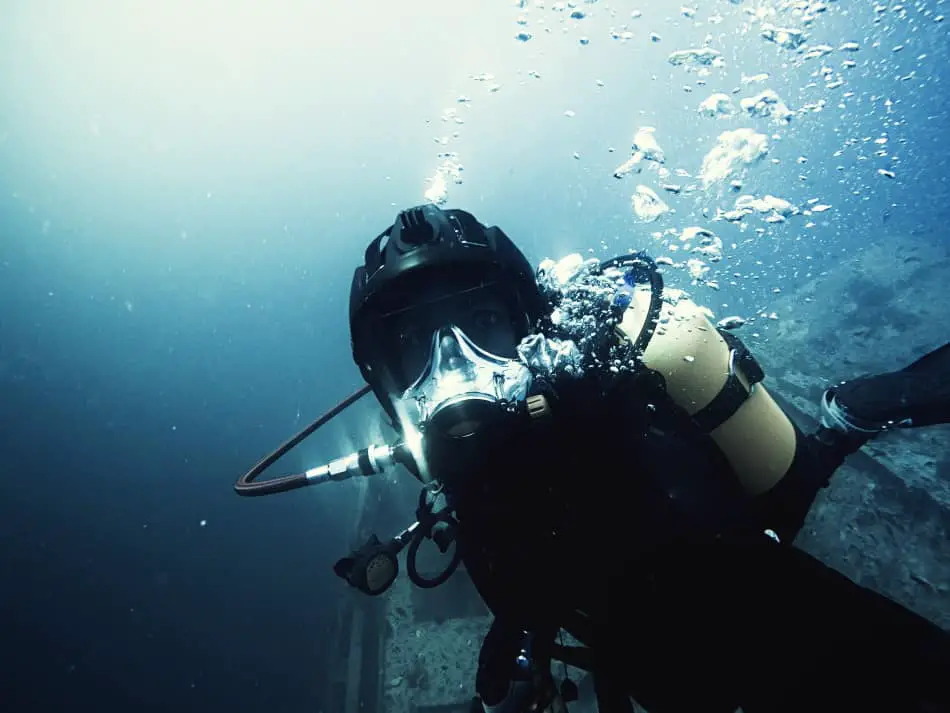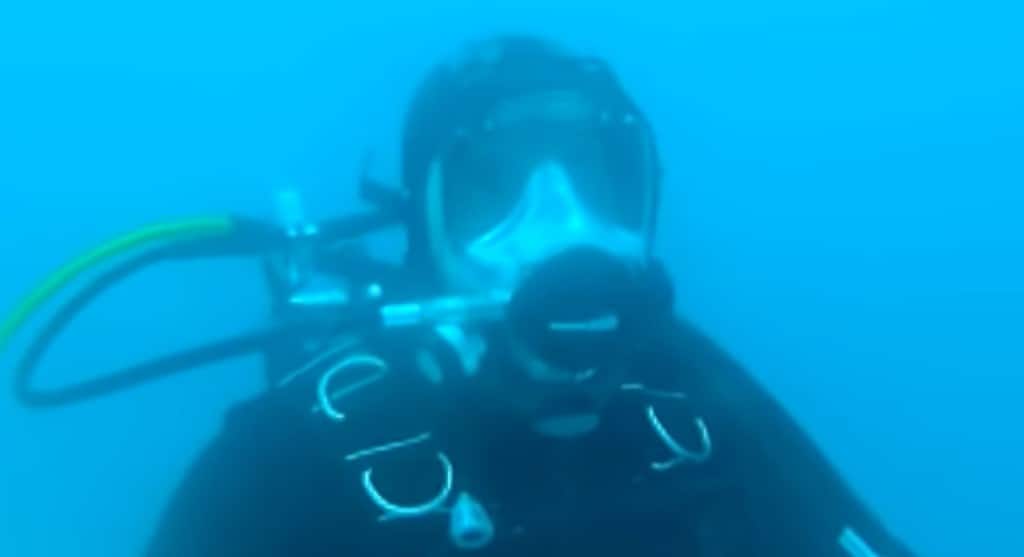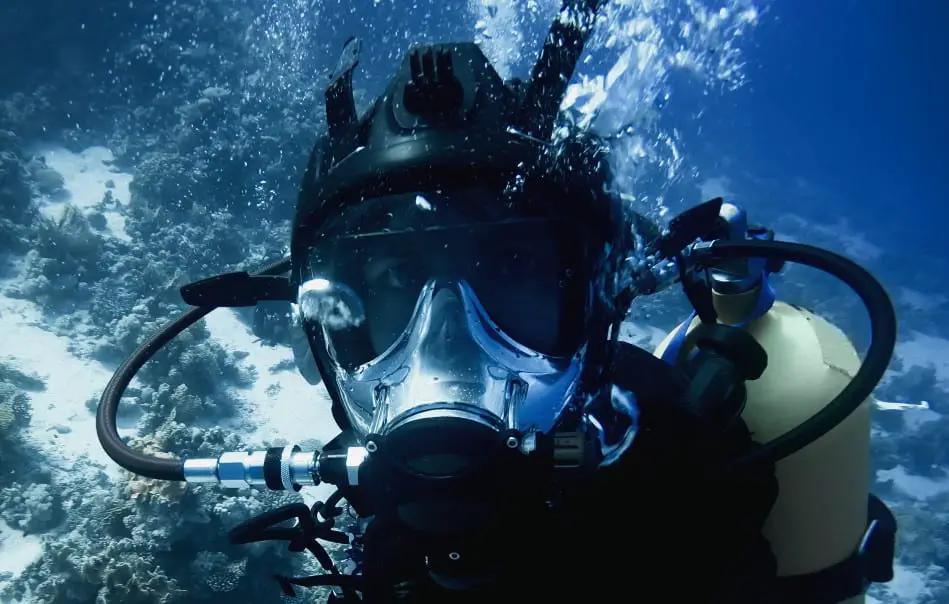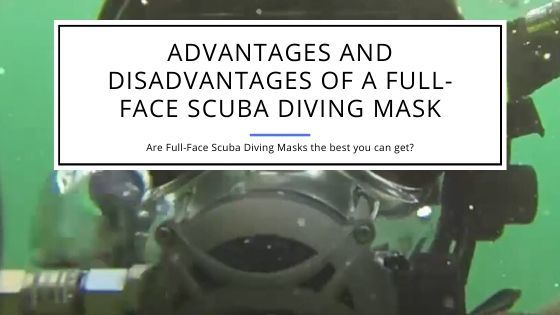Advantages and Disadvantages of a Full-Face Scuba Diving Mask
People are constantly looking for ways to make scuba diving a more comfortable experience for themselves. One relatively recent innovation is the full-face scuba mask. Although previously full-face masks were used by commercial divers and those involved in scientific research, they have recently been introduced for the purpose of recreational diving as well.
What is a Full-Face Scuba Diving Mask?
As the name indicates, a full-face scuba mask covers your entire face. Rather than wearing a mask that covers your eyes and nose and having a separate regulator attached to your mouth, this mask combines the function of both.
It eliminates the need for the diver to hold the regulator in their mouth, which consequently gives them the freedom to communicate with other divers (via an underwater radio system). It also tremendously reduces jaw fatigue as you don’t have to bite down on the mouthpiece of the regulator.
How Does a Full-Face Scuba Mask Work?
The mask consists of a mouthpiece and a demand valve/ gas supply to provide the diver with air. This demand valve may be connected to your air supply in a number of ways, including through the bottom of the mask, through a hole in the silicone skirt or from the top.
Although there are different designs of the full-face mask, they all feature a mechanism to allow divers to breathe in atmospheric air when they are at the water surface. This may include a surface valve or a snorkel air to allow air to enter. This also helps divers save the air in their gas tank for when they are actually underwater.
What Are The Advantages?
There are several reasons why full-face scuba diving masks (Best Scuba Diving Masks – Reviews and Buying Advice) have become popular, not just among professionals but also recreational divers:
Easier Breathing
One of the main reasons why scuba divers prefer full-face masks is that they allow divers to inhale and exhale normally. This helps divers stay calm and helps them concentrate on what’s happening in their surroundings.
The mask also eliminates the need to learn how to manage airflow and practice breathing techniques (all of which are required with a conventional mask).
Unobstructed Views
High-quality full-face scuba masks have a curved lens that provides nearly a complete 180-degree view, which is significantly more than any conventional dive mask. This allows you to observe more marine life and also have a clear view of where your dive buddy is headed.
The Whole Face Is Protected From the Outside
The mask covers your entire face and protects it from getting in contact with water. Conventional masks expose the lower part of your face and may slip off or leak if you move a muscle in your face a certain way. On the other hand, the full-face mask gives you the freedom to breathe comfortably without the danger of the mask slipping. The design is sturdy enough to keep your mask from moving around or slipping in rough waters.
No Jaw Fatigue
Since you don’t have to attach the regulator through a mouthpiece, your jaw won’t get fatigued since you won’t be biting down on anything. You can dive for long periods of time, including multiple dives in a day without feeling any discomfort or worrying about have a sore jaw later on.
No Snorkel Clearing
Traditional snorkels may be used underwater if you’re swimming out to a particular dive point. They usually have a mechanism that prevents water from seeping in, but leakages are still likely to occur.
With the full-face mask, you don’t have a snorkel attached to the mask. Therefore, you also don’t need to take care of your snorkel and clean it after every dive. You also won’t have to deal with little bits of water making you cough and feel uncomfortable when you’re in the water. You can enjoy yourself more without having to worry about swallowing a mouthful of salty water.
Less Fogging Due To Better Air Circulation
Scuba masks generally tend to fog up and obstruct your vision as humidity builds up inside them. Full-face scuba masks generally have an inbuilt ventilation system that keeps air flowing constantly and prevents them from fogging up. The air entering the mask is filtered, circulates inside and then exits the mask.

Optional Underwater Communication
Through a system of integrated underwater intercoms, divers can communicate with their dive partners, the crew on their dive boat and anyone else who is connected to the system. This is particularly useful for divers who are underwater for research purposes or looking for something (such as exploring a newly discovered shipwreck).
Can Be Used When You Have a Beard
With the standard scuba mask, there is a chance of facial hair, such as your beard or other loose hairs, getting stuck in the mask and causing it to leak. Since the full-face mask covers your face entirely, it is a better option for people with mustaches and beards who have trouble dealing with regular masks.
No Risk of Losing Your Regulator
Since the regulator is integrated into the mask itself, there is a lesser chance of you accidentally losing your regulator mid-dive. It is also ideal for people with any sort of dental issues that may make holding onto a regular painful.
This integrated regulator is also quieter than the conventional ones, so it won’t disturb the marine life around you.
Greater Security
The mask has a series of straps instead of a single one. If the straps are properly secured in place, the chances of you dropping your mask are significantly lowered.
Suitable for Colder Climates
When diving in extremely cold climates, scuba divers must wear dry suits to keep their bodies warm. However, research indicates that if your head is exposed to cold temperatures, even if your body is completely insulated, the body’s temperature drops quite rapidly.
The full-face scuba mask helps keep your face warm (and keeps it from getting numb because of the cold) and lets you dive comfortably, especially if you intend to stay underwater for a long period of time.
Provide Safety from Oxygen Toxicity
Oxygen toxicity is a medical concern that arises when divers are exposed to oxygen at very high pressure. This is usually a concern for professional divers who go in very deep and use Nitrox blends or even 100% oxygen as a decompression gas.
If a diver starts convulsing due to oxygen toxicity or is losing consciousness, the full-face mask still makes it easier for them to breathe (and can potentially save the diver’s life) as opposed to a traditional mask where they would have to grip the regulator mouthpiece with their teeth. This is among the top reasons why full-face masks became so important for commercial and scientific divers.

Framed vs Frameless Scuba Diving Mask – What are the Differences?
What Are Some Of The Disadvantages?
Apart from the comfort offered by full-face scuba masks, there are some additional risk factors involved that need to be considered before you decide to use one:
Higher Volume Which Increases Buoyancy
The full-face scuba mask has a higher volume, which inadvertently means a higher level of buoyancy (the diver’s tendency to float in the water).
This basically means the upper body is dragging upward and divers have to exert more effort to maintain the right swimming position. Essentially, divers may end up getting tired much faster with a full-face mask as opposed to a traditional mask.
Bulky Designs
Since full-face masks are larger and heavier, they require a number of straps to secure them in place. These straps are trickier to adjust than those in conventional masks and if something isn’t in place, the mask may flood or come off entirely.
Not for Snorkeling or Free Diving
The deeper you go in the water, the more the pressure will be. Full-face masks are built in such a way that they don’t allow you to equalize this building pressure.
Traditional masks allow you to settle this water pressure by exhaling through your nose. They are the preferred option for freedivers.
Harder to Clear
Full-face scuba diving masks generally don’t flood, but they’re not 100% leak-proof. If it does flood, clearing it out is much harder because you’re working with a larger surface area. That, and since your regulator is part of the mask, you may not be able to breathe until the water is out. This also depends on how much water is in the mask.
Harder to Equalize
While with a conventional mask, you can equalize the water pressure by exhaling through your nose, the full-face mask can’t be treated the same way. You will need special training to learn how to equalize pressure with the mask.
Full-face masks may feature levers around the nose or a cushioned pocket that will help you pinch your nose the same way you would with a regular mask to equalize pressure.
Dropping Your Mask Underwater Becomes Dangerous
If you lose your conventional mask, you can take your time looking for it (since you can already breathe through your regulator). Some divers also keep a spare mask, which they can take out in case of emergencies.
If you drop your full-face mask, you’ll lose both your mask and regulator and it’s crucial that you find your mask as soon as possible. The good news is that the mask will be attached to a regulator hose, so looking for it shouldn’t take too long.
Losing Skills
Long-term users of the full-face mask tend to forget their basic scuba skills training. For instance, since they can communicate via radio, they may forget basic hand signals. These divers may find it difficult to communicate with divers who aren’t using a full-face mask.
Such divers may also forget other basic skills, such as clearing a conventional mask, recovering their regulator, etc. These skills are vital in case the diver needs to use a traditional mask (the other one may be damaged or lost or they may be diving with rented equipment).
For those who are relatively new to scuba diving, it is recommended that they test out both types of masks and are trained accordingly to avoid any emergencies where the diver may panic and struggle with their gear.
Higher Cost and Weight
Full-face scuba masks are generally quite expensive, with prices starting from USD 600 going up all the way to USD 1,500+.
Since they are significantly heavier than traditional masks and have a complete mechanism, you will also need to invest in lessons to learn how to use one properly. Depending on where you are taking training lessons from, this can include an additional cost of up to USD 500. Training will include learning about buoyancy characteristics, off-gassing, equalizing water pressure, etc.
Apart from the monetary investment, full-face scuba masks are also quite heavy, and traveling (Choosing the Best Scuba Fins for Travel) with them can be a tedious task.
Plastic Material
Most full-face masks are mostly made of plastic (with some rubber parts), which can get damaged easily, both in the water and when it is stored.
Plastic masks should be stored very carefully, preferably in a cushioned space where it won’t suffer from scratches, etc.
Best Prescription Dive and Snorkel Masks – Rx Lenses for Scuba Diving

Are Full-Face Scuba Masks Dangerous?
The mask offers some additional safety, such as letting you breathe even if you are experiencing oxygen toxicity side effects of having a panic attack underwater.
However, there are some features that come with added risks. Some full-face scuba masks feature a separate chamber for your mouth and nose – if the plastic faceplate of your mask gets damaged, it will cause the water to enter this inner oronasal part and reduce your air supply or cut it off, which can be life-threatening. This is the main element that can be dangerous for scuba divers.
Conclusion
Despite some obvious drawbacks, full-face scuba diving masks have much to offer, especially for professional divers. They allow for verbal communication (so that divers don’t have to completely rely on hand gestures), a clearer view and have a safer breathing system.
They are technically a little more complicated to use and considerably more expensive. At the end of the day, for recreational divers, it comes down to personal preference. It is recommended that you test out both in the water to find out which one is more comfortable for you. If you have the room in the budget, you can have one of each in case you occasionally go deep diving and need to be able to breathe more freely.

